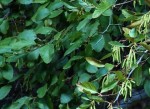 White alder is native to western North America where it grows along river banks, marshes, and other moist or wet areas. It is very useful for areas that are wet as well as in infertile soils because its roots can fix nitrogen. The wood of white alder is water repellent and it can be used for erosion control but the tree is also useful as a windbreak, or as a backdrop in a garden setting. It is deciduous in the northern part of its range but retains its leaves in the southern part such as Southern California. The large, glossy leaves are attractive and quiver in the slightest breeze while the male catkins provide an interesting and unique feature. The overall appearance of the tree is delicate with its horizontal branches that arch at the tips so that they appear slightly weeping. White alder is a member of the birch family, Betulaceae, that also includes hazels and hornbeams. The genus name, Alus, is the classical name for one of the genera. The specific epithet, rhombifolia, comes from the Greek word rhomboeides, meaning rhomboidal, and the Latin word folia, meaning leaf, and refers to the shape of the leaves.
White alder is native to western North America where it grows along river banks, marshes, and other moist or wet areas. It is very useful for areas that are wet as well as in infertile soils because its roots can fix nitrogen. The wood of white alder is water repellent and it can be used for erosion control but the tree is also useful as a windbreak, or as a backdrop in a garden setting. It is deciduous in the northern part of its range but retains its leaves in the southern part such as Southern California. The large, glossy leaves are attractive and quiver in the slightest breeze while the male catkins provide an interesting and unique feature. The overall appearance of the tree is delicate with its horizontal branches that arch at the tips so that they appear slightly weeping. White alder is a member of the birch family, Betulaceae, that also includes hazels and hornbeams. The genus name, Alus, is the classical name for one of the genera. The specific epithet, rhombifolia, comes from the Greek word rhomboeides, meaning rhomboidal, and the Latin word folia, meaning leaf, and refers to the shape of the leaves.
Type: Deciduous tree or shrub
Outstanding Feature: Tolerance of wet and infertile soil
Form: Open, broad, rounded crown
Growth Rate: Fast
Bloom: Flowers are unisexual (monecious) with catkins first appearing in early spring; male catkins are pendulous and borne in clusters of two to five while female catkins are short and thick and borne at the end of branches; fruits resemble small cones and may persist on the tree for over a year.
Size: 25-40’ H x 40’ W
Light: Full sun; tolerates some shade
Soil: Average to poor, moist to wet, neutral pH 6.5 to 7.2
Hardiness: Zones 6-10
Care: Prune when young to establish shape; winter or early spring pruning later when necessary.
Pests and Diseases: None of significance
Propagation: Seed; stratification needed at 41 degrees for 180 days if seeds have dried in storage; softwood cuttings.
